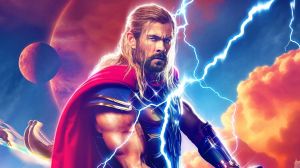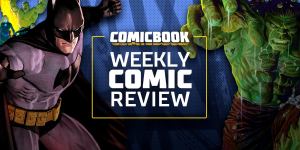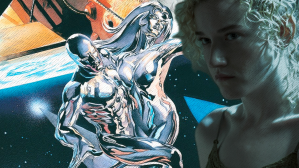With yesterday’s trailer for Deadpool 2 bringing together a small group of over-the-top, gun-toting mutants from the ’90s and today’s Venom trailer teasing an agonized, scientifically-augmented start for the spider-powered antihero, we found ourselves wondering: how extreme are the Marvel movies going to get in the next few years?
Videos by ComicBook.com
While Fox and Sony are technically not “Marvel” proper, the inclusion of Spider-Man in the Marvel Cinematic Universe and the loomin acquisition of Fox by Disney (with studio execs saying that they would continue to make Deadpool sequels) implies that each of these films are at least fairly close to being “Marvel movies” in the traditional sense.
And, hey, this is largely a mental exercise in having fun with the extreme tropes that were popularized in the ’90s, when these characters were created and sold the most comics.
So…what other Marvel characters might get their own new, extreme movies?
We have some ideas…!
Thunderstrike

Aside from his name and look, there is not much to Thunderstrike that is more extreme than Thor himself.
In fact, one might argue that the Marvel Cinematic Universe’s Thor, influenced by Thunderstrike, the Ultimate Universe, and all of the other things that have come in the years since Tom DeFalco and Ron Frenz introduced Eric Kevin Masterson to the world in 1988.
Still, he was one of the earliest examples of younger, “cooler,” and usually more “extreme” versions of heroes coming to take over the duties of Silver Age counterparts. He was not the absolute first — there were replacements for Captain America going back before this, and of course Wally West took over as The Flash when Barry Allen died in the Crisis on Infinite Earths a couple of years before Thunderstrike was a thing — but what differentiated Thunderstrike from those previous examples is that he broke away from Thor’s visual aesthetic and brought something of an update with him when he took over the “classic” identity, paving the way for characters like Kyle Rayner, Jean-Paul Valley, and so forth.
Of course, Thunderstrike might be a hard sell in the MCU: not only is Mjolnir gone, at least for now, but the idea of a regular human “transforming” into Thor is not one which has been adopted by the movies. That would leave some big questions as to how Masterson got his powers…although nothing that could not be glossed over with “pieces of Mjolnir moving through the cosmos” or something like that.
Vengeance
Because “dude with a flaming head on a fiery motorcycle” wasn’t badass enough, Marvel Comics in 1993 introduced Michael Badilino, codnamed Vengeance.
Created by Howard Mackie and Ron Wagner, Badilino was an undercover cop with family ties to the mob, who became an even more extreme spirit of vengeance than Ghost Rider and joined up with the Midnight Sons, one of a number of supernatural and often ultra-violent Marvel super-teams around that time.
In spite of being a cop and theoretically not a bad guy unto himself, he blamed Ghost Rider for the death of his mob boss dad, and made a deal with Mephisto to get powers to kill the Rider.
Given that visual effects are the best part of basically every iteration of Ghost Rider so far, giving Vengeance his own Venom-like movie where he is maybe doing the wrong thing for the right reasons could be a really interesting, and visually spectacular, approach. Just…make sure it’s good this time.
Ravage 2099

Paul-Phillip Ravage, who became the mutated antihero Ravage, was always kind of a weird case. Ravage 2099, which featured most of his stories, was part of a line of comics reinterpreting Marvel’s most famous and popular heroes into high-tech, futuristic versions of themselves.
So, how the hell did “Ravage” make the cut?
Well, because in 1993, he was created by Stan Lee and Paul Ryan, marking one of the the last times Lee would develop an original character for Marvel.
He has a weird backstory involving corporate abuse of power, eco-terrorism, and Ravage himself basically being a guy who gets screwed by everyone, all the time. It’s not a great book but it is far from bad — and it is the best way for Marvel to tell one of their 2099 stories without totally blowing up the continuity of the MCU.
Mutant X

More X-Men! More alternative universes! More opportunities to baffle the audience and give Deadpool joke ideas!
Okay as self-evidently extreme as Marvel’s Mutant X was, it was actually a great book full of rich characterization, which used familiar characters but put them in unfamiliar situations, and used the “alternate earth” idea to divorce itself from the complications of X-Men’s impenetrable continuity.
That is, on the face of it, exactly what the movies should be doing, and what worked so well for Logan. And this would be not just Logan but a half-dozen characters.
Penance

The mutant who would eventually become Hollow began as Penance.
And really it’s mutants, not mutant.
Not becuase it’s a legacy hero but because she was riffing on something Justice League International had done with Crimson Fox around that time, and the character was in fact twin sisters. The big difference is that the sisters would merge to become Penance, rather than just trading off.
Penance, who has a hard, red, spiky appearance that makes her look like a reject from DC’s Bloodlines event, was created by Scott Lobdell and Chris Bachalo for the first run of Generation X. Her backstory is that she lost her voice, gained her strange appearance and powers after being cursed by someone she had wronged.
Ouch.
Darkhawk

After seeing that his dad was mobbed up, Christopher Powell gained powers via an amulet that became attached to his body. He had enhanced strength, vision, speed, and he could fly and shoot energy out of the amulet on his chest. When fighting crime, he had an armored costume that essentially formed around him. It would go away but the gem remained.
His look is very ’90s, and while it could be argued that he is no moreso than dozens of other characters created during this time, his series (largely by Danny Fingeroth and Mike Manley, although it is not Fingeroth but editor Tom DeFalco who is credited with co-creating the character) was as extreme as you could get.
Darkhawk is a character who has been mentioned in conversations about TV and film before; the character is young, has an interesting hook, and the costume is vislaly distinct (plus, could get a Star-Lord-style update/upgrade on the way to the movies), so he is probably the most likely person on this list to see in a solo adventure.
Foolkiller

Gregory Salinger, one of the characters to be called “Foolkiller,” is basically the best bet Marvel has for their own non-Fox-involved Deadpool-style character.
The first Foolkiller killed people who he felt had slighted Christianity, making him the rare evangelical superhero who was not overtly a critique of religion but used it to guide him.
Salinger was a person who had mental problems, and selected the villains who were his “fools” more randomly, but the idea of a guy in a ski mask killing bad guys while cracking wise and having a take-no-prisoners mentality is obviously something that resonates with the same fans who are excited about more seasons of The Punisher.
Bishop

While Bishop might not be quite as self-evidently EXTREME as some of the other characters on this list, he remains a close corollary to Cable.
Big hair, big guns, time travel, dystopian future, bad attitude — all of these things were key to Bishop’s initial appeal and all of these things fit perfectly into the archetype of the ’90s extreme antihero.
Bishop has appeared in live-action movies before (X-Men: Days of Future Past, in which he was played by Omar Sy), but the hero has never really had more than a few moments onscreen at a time.
This seems like the perfect time to change all that!
The ‘Heroes Reborn’ Universe

Just…just all of it.
There is a lot to unpack here, but the gist is that after all of Earth’s non-mutant heroes (except Spider-Man, the slacker!) sacrificed themselves to stop the X-Men villain Onslaught, readers found their favorite comics relocated to a new universe where updated versions of the heroes lived.
It was a bit like the Ultimate Universe, except it was the “official,” canonical versions of the characters at the time…oh, and it was written and drawn mostly by Marvel expats who had left to work at Image years before (including X-Force creator Rob Liefeld and current DC co-publisher Jim Lee).
While the aesthetic of the Heroes Reborn Universe is very “extreme,” and many of the books started out with two strikes against them because they were replacing some fairly popular comics in the name of a gimmick and a sales bump, there are a number of things — including the pervasive influence of SHIELD, giving Falcon a military background, and many more — that make the Heroes Reborn Universe feel pretty familiar to fans of the Marvel Cinematic Universe.
Meanwhile, introducing an “alternate reality” version the top-tier heroes might be a way to get around expiring contracts, and keep making sequels to some of the studio’s most popular characters even in the days after Downey, Evans, and Hemsworth have drawn to a close.
Adam X

You didn’t really think we would make it all the way to the end of this list without mentioning him, did you?
Adam X, otherwise known as Adam X-Treme (yes, really), was a mutant who was introduced by Fabian Nicieza and Tony Daniel in 1993. A Shi’Ar/mutant hybrid, the character was at one point intended to be the third Summers brother (along with Cyclops and Havok) but those plans deteriorated.
But I mean…just look at this magnificent bastard. Soul patch, backwards baseball cap, long hair with a single braid, and blades which serve no readily-obvious purpose all over his shoulders.
The only thing more extreme than that cover is the fact that someone MADE IT AS A PAINTING or a trading card.





